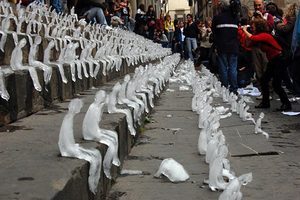Environmental Awareness UnitSunday, March 10, 2013 at 1:38 pm
Global warming causes lakes to disappear in Chile
On April 10th, Cachet Lake in Chile, S.America, dried up overnight. Scientists believe that the whole "disappearing" phenomenon is due to global warming.Ice Sculptures Highlight Global Warming
On Wednesday, a thousand little people were seen melting away in the sweltering heat at Berlin's Gendarmenmarkt Square - and there was no saving them, because these little guys were sculptures made out of ice by Brazilian artist, Nele Azevedo.Will Giant Bubble Baths Help Stop Global Warming?
We humans have learned that bubble baths go a long way in soothing frazzled nerves and helping us relax. Now, a scientist from Harvard University in Cambridge, believes that giving our waters the same treatment, may have a similar effect on our Planet, and help stop or at least slow down global warming.How The Seahorse Got Its 'Curves'
Scientists have often wondered why the seahorse, with its curvy neck and snout resembles a horse, to which it has no relationship, rather than its closest cousin, the straight bodied and rather ordinary looking - Pipefish. Now, a researcher believes he may have the answer and as is the case in any kind of evolution - It's to do with survival.Are Plants Crucial For Humans To Survive? This Scientist Is About To Find Out
The fact that plants absorb harmful carbon dioxide and emit oxygen that humans need to survive, has been well documented for many years now. Despite that, we seem to continue to treat plants like second-class citizens - Something geologist Iaian Stewart is trying to change, by spending 48-hours inside a sealed box.Can This 'Miraculous' Molecule Help Reverse Global Warming?
It seems that we may have a new ally in our quest to reduce global warming - A molecule that goes by the name of Criegee biradica or Criegee Intermediate. If experts are to be believed, this newly discovered oxidizer that is present in our atmosphere has the potential to cool down the Earth and help offset global warming.Scientists Create Transparent Soil To 'Spy' On Plants!
For many years, scientists have been trying to unravel the mystery of what really goes on in plants in the parts that are not visible to us - That is, around the roots that lie underground hidden by dense soil. Now, thanks to researchers from Scotland's University of Abertay Dundee, they may finally be able to solve this mystery that is as old as the Universe itself!Can We Refreeze The Arctic? This Scientist Certainly Thinks So
Thanks to global warming, the ice in the Arctic Ocean is today about half of what it was in the 1980's. Given that the situation can only get worse and governments are unable to come to a consensus about how to reverse the trend, one scientist is proposing a radical solution - To use modern technology to repair the damage.Elusive Giant Squid Finally Caught On Camera
Giant squids, the kind referred to in Jules Verne's 1870 novel, Twenty Thousand Leagues Under the Sea, have been known to exist for many centuries. However, finding the world's largest invertebrate in its natural habitat had proved a little elusive. Now, thanks to some patient Japanese researchers, we can all finally get a glimpse of this magnificent cephalopod!2013 Australian Summer May Be One For The Record Books
While summers in the world's driest inhabited continent AKA Australia can get a little uncomfortable, this year seems to be starting out a little more extreme than usual. On Monday January 8th, the Australian meteorological dept reported an average continent temperature of 104.6°F (40.33°C) - Surpassing a record set in 1972. And, the forecast for the rest of the season looks even worse.Emperor Penguin Colony Welcomes First Human Visitors
In December 2012, three men braved Antarctica's treacherous and remote Princess Ragnhild Coast to seek out a colony of Emperor Penguins that has hitherto just been suspected to exist. They were not disappointed!Researchers Believe Flowers Evolved Their Color To Attract The Best Pollinators
Though researchers have known for many years that certain flowers have evolved their colors to attract bees as their pollinators, the same had not been confirmed about those that solely depend on birds to do the job. Now, a report published in the March issue of New Phytologist by a team of Australian scientists, reveals that this is indeed the case, at least for their local flowers.Join Class
If you are a student and would like to join this class, type in the Class Code below and click 'Join Class'.











